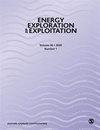Real-time prediction of multivariate ROP (rate of penetration) based on machine learning regression algorithms: Algorithm comparison, model evaluation and parameter analysis
IF 1.6
4区 工程技术
Q4 ENERGY & FUELS
引用次数: 1
Abstract
ROP (Rate of Penetration) is a comprehensive indicator of the rock drilling process and how efficiently predicting drilling rates is important to optimize resource allocation, reduce drilling costs and manage drilling hazards. However, the traditional model is difficult to consider the multiple factors, which makes the prediction accuracy difficult to meet the real drilling requirements. In order to provide efficient, accurate and comprehensive information for drilling operation decision-making, this study evaluated the applicability of four typical regression algorithms based on machine learning for predicting pore pressure in Troll West field, namely SVR (Support Vector Regression), Linear regression, Regression Tree and Gradient Boosting regression. These methods allow more parameters input. By comparing the prediction results of these typical regression algorithms based on R2(R-Square), explained variance, mean absolute error, mean squared error, median absolute error and other performance indicators, it was found that each method predicted different results, among which Gradient Boosting regression has the best results, their prediction accuracy is high and the error is very low. The prediction accuracy of these methods is positively correlated with the proportion of the training data set. With the increase of logging features, the prediction accuracy is gradually improved. In the prediction of adjacent wells, the ROP prediction methods can achieve a certain prediction effect, which shows that this method is suitable for ROP prediction in Troll West field.基于机器学习回归算法的多变量ROP实时预测:算法比较、模型评估和参数分析
ROP(钻速)是岩石钻探过程的综合指标,有效预测钻速对优化资源分配、降低钻探成本和管理钻探危险具有重要意义。然而,传统的模型难以综合考虑多种因素,使得预测精度难以满足实际钻井要求。为了为钻井作业决策提供高效、准确、全面的信息,本研究评估了四种典型的基于机器学习的回归算法在Troll West油田预测孔隙压力方面的适用性,即SVR(支持向量回归)、线性回归、回归树和梯度提升回归。这些方法允许输入更多的参数。通过比较这些典型的基于R2(R-Square)的回归算法的预测结果、解释方差、平均绝对误差、均方误差、中值绝对误差等性能指标,发现每种方法预测的结果不同,其中梯度Boosting回归的结果最好,预测精度高,误差很低。这些方法的预测精度与训练数据集的比例呈正相关。随着测井特征的增加,预测精度逐渐提高。在相邻井的预测中,ROP预测方法能够达到一定的预测效果,表明该方法适用于Troll-West油田的ROP预测。
本文章由计算机程序翻译,如有差异,请以英文原文为准。
求助全文
约1分钟内获得全文
求助全文
来源期刊

Energy Exploration & Exploitation
工程技术-能源与燃料
CiteScore
5.40
自引率
3.70%
发文量
78
审稿时长
3.9 months
期刊介绍:
Energy Exploration & Exploitation is a peer-reviewed, open access journal that provides up-to-date, informative reviews and original articles on important issues in the exploration, exploitation, use and economics of the world’s energy resources.
 求助内容:
求助内容: 应助结果提醒方式:
应助结果提醒方式:


